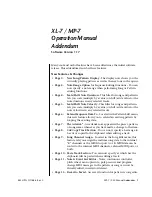
P/N 53063-30, Manual revision: B
4-2
Preparing for a Cell Saver 5+ Procedure
U
NDERSTANDING
GENERAL
SYSTEM
OPERATION
This chapter provides a general overview of how the Cell Saver 5+ system
works. Detailed instructions for each protocol performed by the CS5+
system are provided in
Chapters Five, Six and Seven
.
Collecting blood
The collection of blood is the simplest of the Cell Saver system tasks. The
blood is drawn into a collection reservoir (such as the LN205) through an
aspiration and anticoagulation (A&A) assembly (such as the LN208).
The A&A assembly described in
Mixing of AC solution and blood occurs in the small mixing chamber of the
tubing connector. This mixing chamber is located after the suction tip which
is used to remove blood and fluids from the wound. The blood and fluids are
then collected in the collection reservoir.
Warning: AC solution must be added to a saline solution suitable for intra-
venous use. Sterile water or other irrigating solution must not be used.
It is important that shed blood suctioned from a patient be collected in a
sterile container such as the LN205 Collection Reservoir, even if there is
some doubt that the amount collected will be sufficient to warrant
processing by the Cell Saver system. Once the blood is collected in the
reservoir, it may be processed if desired or discarded. Using the reservoir
leaves open the option of processing the blood.
Filling the centrifuge bowl
Once the disposable set has been loaded, the operator should press the Start
key on the front panel. The CS5+ device will automatically initiate a fill
cycle when the appropriate level of fluid has been collected into the reser-
voir.
Note: The default level is 800 ml for the Latham bowls and 400 ml for the
70mL Bowl, however, the operator can press the Start key a second time to
initiate a fill cycle before this level is reached.
At this point the centrifuge bowl begins to spin and the red line valve opens.
The bowl begins to fill as the pump transfers fluid from the reservoir while
monitoring the volume of fluid being pumped.
Separating and packing the cells in the bowl
The spinning of the centrifuge traps the heavier red blood cells and causes
them to be driven toward the outer walls of the centrifuge. Red blood cells
form the outer layer while the supernatant plasma floats inward toward the
core of the bowl. The lighter fraction is forced out the effluent tubing from
the bowl and into the waste bag.
















































